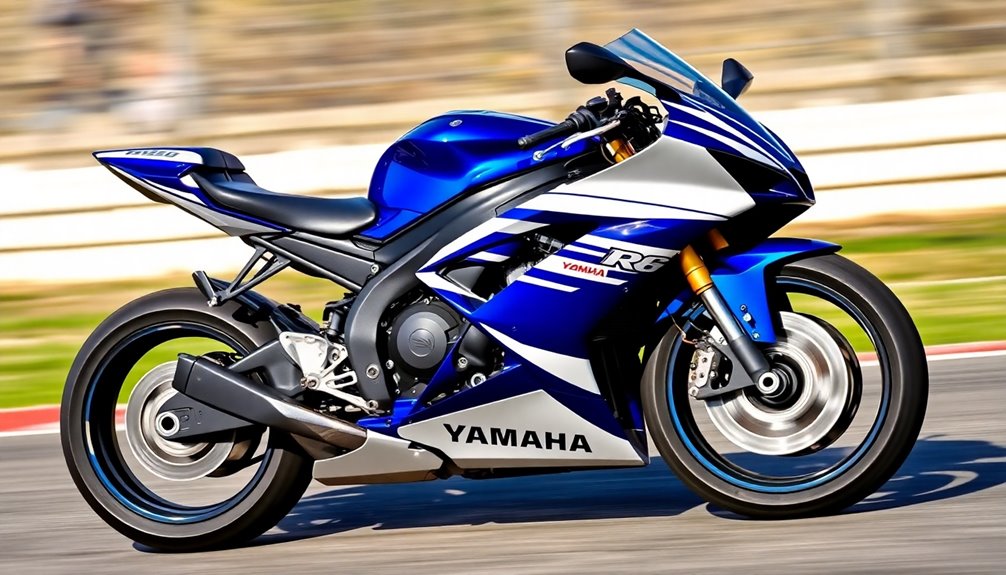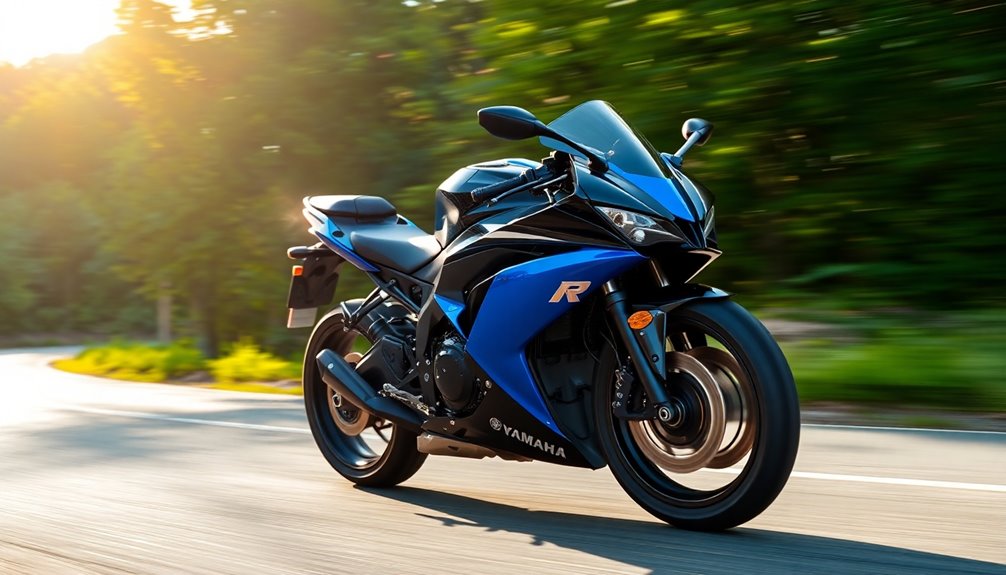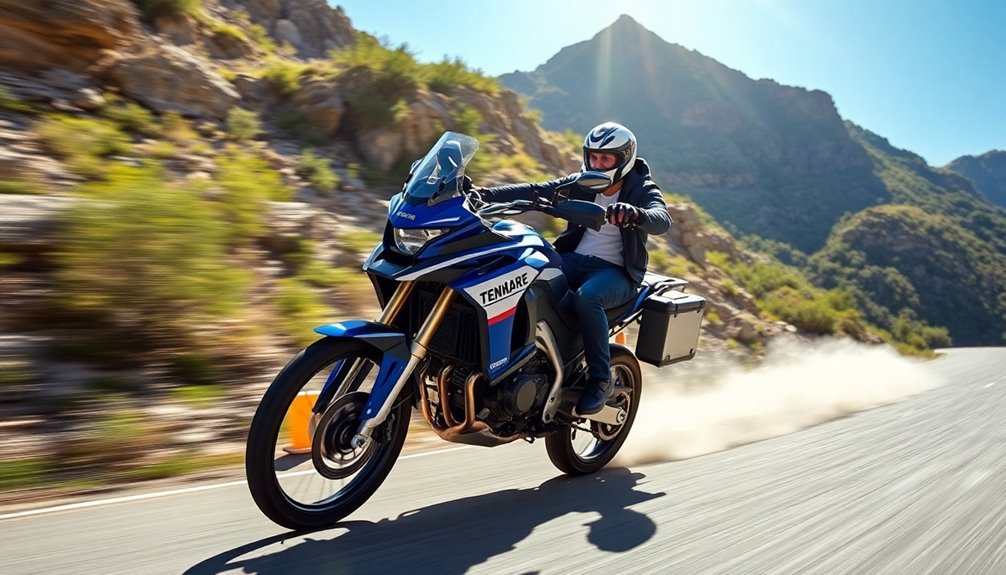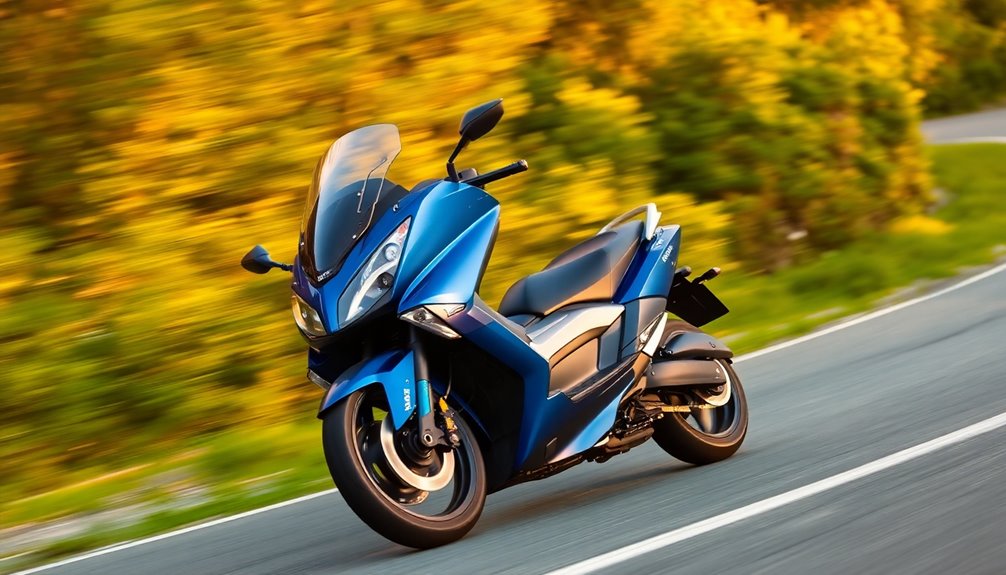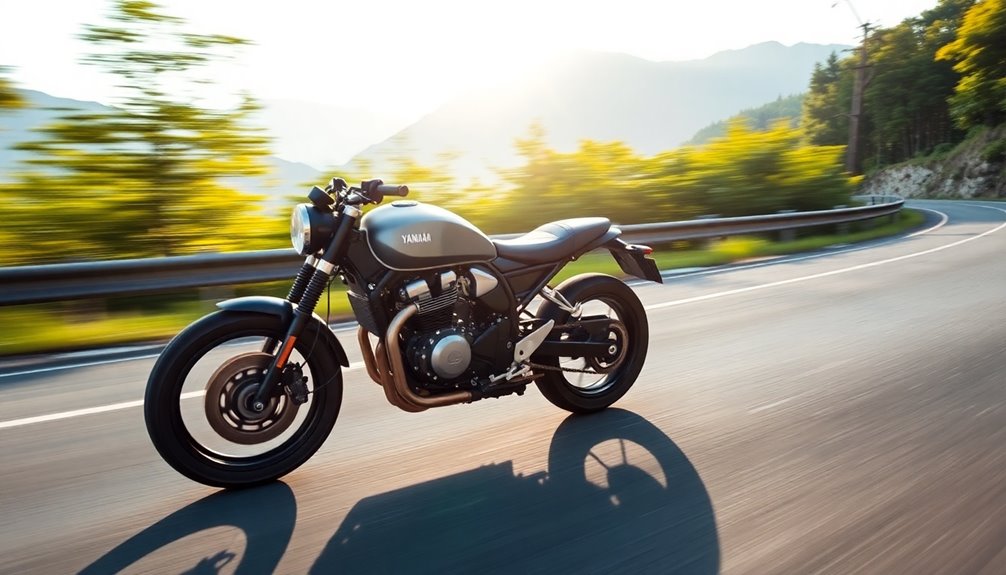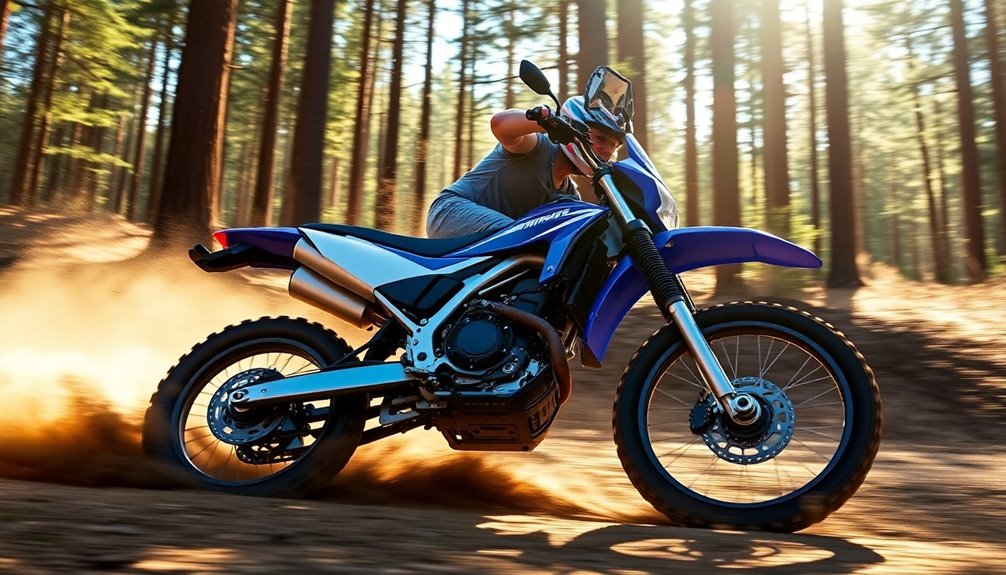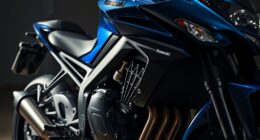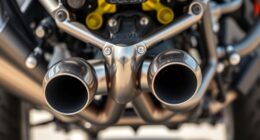The Yamaha R6 is a legendary 600cc supersport that can hit an impressive top speed of 165 mph. Its lightweight aluminum frame and high-revving 599cc engine, producing 116 hp, contribute to that exhilarating performance. With features like advanced traction control and a slipper clutch, it offers unmatched control during aggressive riding. The aerodynamic design enhances stability and grip, allowing for agile handling in turns. Plus, with a comfortable riding position and focused ergonomics, you'll feel confident whether on the track or the street. Keep exploring to uncover what makes the R6 a top choice for sport bike enthusiasts.
Key Takeaways
- The Yamaha R6 achieves a maximum velocity of 165 mph, showcasing its impressive performance in the supersport category.
- Powered by a 599cc DOHC liquid-cooled engine, it produces 116 hp and 45.5 pounds-feet of torque for exhilarating acceleration.
- Its high power-to-weight ratio allows the R6 to accelerate from 0 to 60 mph in just 3.0 to 3.19 seconds.
- The advanced engine management system and YCC-T technology ensure optimized throttle response for a thrilling riding experience.
- Aerodynamic design and lightweight materials contribute to overall performance, enhancing speed and handling capabilities on the track.
Lightweight Aluminum Frame Design

The Yamaha R6's lightweight aluminum frame design is a standout feature that enhances its performance and handling. Crafted using a cost-effective hydro-forming technique, the frame benefits from years of Grand Prix development, optimizing geometry, engine positioning, and rigidity. This combination of mold castings and pressed aluminum plates results in a fully stressed chassis member, cutting down on weight and bulk while improving stiffness.
You'll appreciate the Deltabox aluminum frame, which balances rigidity for that light and agile handling. The top spars are positioned as close to the frame's torsional axis as possible, ensuring maximum stability. Plus, the ram air duct running through the frame enhances airflow for improved engine performance. Additionally, the R6 features a lightweight titanium valves design that contributes to its championship-winning horsepower.
The magnesium rear subframe centralizes mass, making your ride more responsive. At only 20 mm narrower at the seat-tank junction, it allows for swift rider movements.
The lightweight "gull wing" swingarm reduces unsprung weight, enhancing suspension performance. With a carefully optimized swingarm pivot position, it minimizes squat during hard throttle openings.
All these elements combine to give you an exhilarating ride that feels both connected and controlled on the road.
Engine Efficiency Insights

When it comes to engine efficiency, you'll appreciate how the Yamaha R6 achieves a maximum velocity of 165 mph, thanks to its finely-tuned throttle response dynamics. The aerodynamic bodywork plays a crucial role in minimizing drag, allowing you to experience peak performance at high speeds. Additionally, the R6 features advanced electronics such as traction control and a quick shifter, enhancing both performance and rider confidence. Understanding these elements will give you a clearer picture of what makes the R6 so exhilarating on the road.
Maximum Velocity Achieved: 165 Mph
Achieving a maximum velocity of 165 mph, the Yamaha R6 showcases exceptional engine efficiency that sets it apart in the supersport category. This impressive speed, verified by Motorcycle News, highlights the R6's powerful 599cc DOHC liquid-cooled four-cylinder engine, which produces 116 hp and 45.5 pounds-feet of torque. The R6's top speed has been consistently recognized as one of the fastest among Yamaha bikes since 1999.
With a high power-to-weight ratio of 200 horsepower per liter, the R6 accelerates from 0 to 60 mph in just 3.0 to 3.19 seconds, demonstrating its engineering prowess.
The R6's design features a Deltabox aluminum frame, optimized for rigidity and balance, while a back torque-limiting slipper clutch aids in maintaining control at high speeds. With a compression ratio of 12.8:1, the engine utilizes advanced technologies, including fuel injection with Yamaha Chip Controlled Throttle and TCI for optimal performance.
Compared to competitors, the R6's top speed significantly surpasses the Yamaha R7's 139 mph, solidifying its status as one of the fastest 600cc motorcycles available.
The blend of aerodynamic design, robust engine specifications, and cutting-edge technology makes the R6 an outstanding choice for those seeking speed and performance on the track.
Throttle Response Dynamics
With its advanced engine management system, the Yamaha R6 delivers remarkable throttle response that enhances your riding experience. Thanks to the YCC-T (Yamaha Chip Controlled Throttle), you'll enjoy precise control over your acceleration. This ride-by-wire system translates your inputs into instantaneous throttle adjustments, making it easier to navigate tight corners or unleash power on straightaways. The integration of YCC-I (Yamaha Chip Controlled Intake) optimizes power delivery across the entire RPM range, ensuring you feel that rush as you hit higher revs. You'll notice that peak power arrives at an exhilarating 14,900 RPM, with peak torque kicking in at 11,000 RPM. While the engine has a 'peaky' power delivery, its high-revving nature encourages you to push the limits. Additionally, the multiplate slipper clutch enhances your handling during aggressive downshifts and braking, allowing you to maintain control even in challenging conditions. Notably, the R6 boasts a curb weight of 195 kg (430 lbs), which contributes to its agility and performance dynamics. Together, these features create a highly responsive engine that not only meets performance demands but also adapts to your riding style, making the R6 a true standout in the supersport category. Experience the thrill of the R6's throttle response for yourself.
Aerodynamic Bodywork Design
The Yamaha R6's performance isn't just about power; its aerodynamic bodywork plays a pivotal role in maximizing engine efficiency. Extensive wind tunnel testing has refined its profile to achieve a lower drag coefficient, resulting in an impressive 8% improvement in aerodynamic efficiency compared to previous models. This design not only improves airflow for cooling but also enhances downforce, giving you better grip during cornering. Additionally, the use of advanced technology in heat pumps similarly enhances efficiency and energy management. Heat pumps are essential for maintaining consistent indoor temperatures in commercial spaces, showcasing how innovative design is critical across various applications. The integration of energy-saving features in heat pumps can lead to significant reductions in overall energy consumption.
Lightweight materials like plastics and carbon fiber are used in the fairings, reducing weight while maintaining strength. The high-strength aluminum frame adds durability and rigidity, while the magnesium alloy sub-frame further improves handling. You'll notice the benefits of these choices as the bike feels nimble and responsive at high speeds. The use of high-quality European carbon fiber in the bodywork contributes significantly to the bike's overall performance and aesthetics.
The R6 features an aerodynamic front cowl and integrated turn signals to minimize drag. With deep knee recesses in the fuel tank, you can tuck in for a better riding position. The centralized mass keeps the engine components close to the bike's center, enhancing stability. Regular maintenance of the bike, like that of heat pumps, can prolong its lifespan and ensure optimal performance.
All these elements come together to boost your confidence and performance on the track, allowing you to reach impressive top speeds effortlessly.
Rider Comfort and Ergonomics

Rider comfort and ergonomics play a crucial role in the overall experience of riding the Yamaha R6. With a seat height of 850 mm, this bike accommodates riders of various sizes, allowing you to feel secure and confident. The forward lean encourages an aggressive riding position, perfect for sport enthusiasts.
You'll appreciate the strategically placed footpegs, which enable swift body weight shifts during cornering, enhancing your control. The handlebars are designed at a height that strikes a balance between comfort and control, minimizing back strain during longer rides.
As you navigate corners, you'll find yourself sliding back from the tank, using your outside leg for support, which ensures a stable body position. The R6 also comes equipped with a digital console that keeps you informed about speed, gear position, and fuel levels, while the electric start system makes starting effortless. Additionally, the bike features a wet multi-disc slipper clutch for smooth gear shifts, providing even better control during aggressive riding.
Its advanced suspension system, featuring 43mm USD forks and a rear monoshock, provides outstanding handling and stability. Plus, the fairing design offers wind protection, so you can stay focused on the road ahead. Overall, the Yamaha R6 prioritizes rider comfort without compromising performance.
Owner Feedback: Performance Insights

Owner feedback on the Yamaha R6 often highlights its impressive performance capabilities, particularly on the track. Riders rave about the bike's high-RPM engine, which can rev up to 15,800 rpm, delivering an exhilarating power output of up to 116.8 hp in later models. The torque also impresses, especially at 10,500 rpm, but many note that the low-end power can feel lacking, requiring you to keep the engine in its optimal range for the best performance.
The R6's sharp handling and agility receive consistent praise. Its Deltabox frame design enhances stability, and the 43 mm inverted front fork, along with the new rear shock, allows for precise cornering. Riders appreciate the deep braking capabilities, especially when upgraded with steel braided brake lines for improved feel. Additionally, the bike's best-in-class handling allows riders to tackle corners with remarkable confidence and speed.
However, some owners express disappointment with its street usability. The bike's track-focused design demands frequent gear changes, and the absence of a fuel gauge is a common inconvenience.
While it excels in racing conditions, daily riders might find its low-end performance challenging, making it less suited for casual riding. Regular maintenance is essential to keep it performing at its best.
Market Positioning Against Rivals

In the competitive landscape of supersport motorcycles, the Yamaha YZF-R6 stands out with its blend of cutting-edge technology and performance. Its sleek design, influenced by the YZF-R1, catches the eye, while the lightweight frame and enhanced suspension provide remarkable handling.
You'll appreciate the advanced electronic rider aids, such as traction control and a quick shift system, which elevate your riding experience. The R6 features a design that achieves an 8% aerodynamic improvement over previous models, further enhancing its performance on the track.
When it comes to market positioning, the R6 shines against rivals like the Kawasaki Ninja ZX-6R and Suzuki GSX-R600. The R6's competitive pricing and impressive performance figures, including a top speed of 161.3 mph, make it a strong contender.
As the supersport market shifts towards lighter and more agile bikes, the R6 fits perfectly, addressing the growing demand for track-ready features.
Sales figures back this up, as riders are drawn to the R6's powerful combination of technology and performance. With its compliance to Euro4 emissions standards, it also showcases Yamaha's commitment to environmental responsibility.
In a crowded field, the Yamaha YZF-R6 proves to be a formidable player, balancing speed, agility, and modern features that appeal to both track enthusiasts and everyday riders alike.
Performance Tuning Options
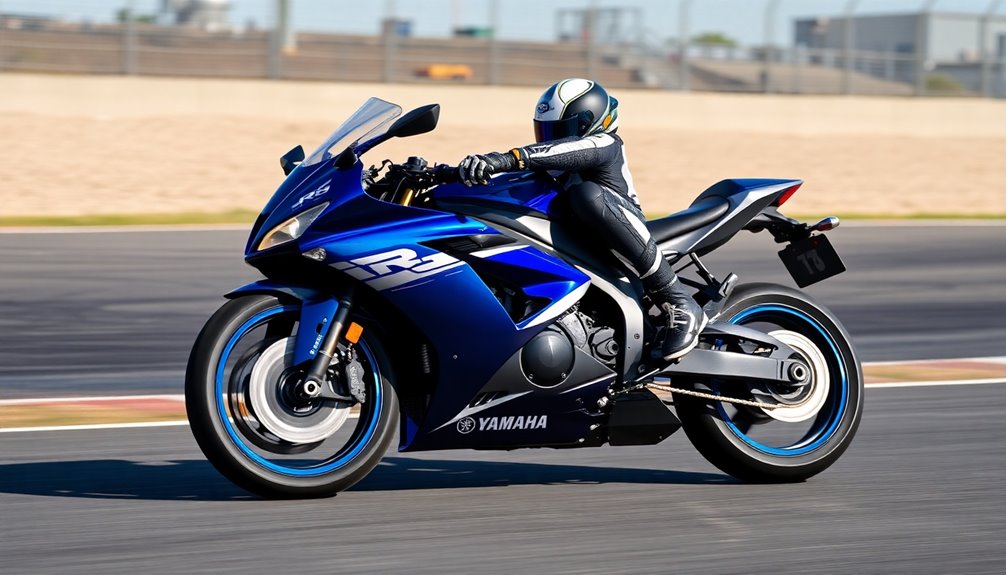
With its strong market positioning, the Yamaha YZF-R6 not only impresses with its performance but also offers numerous options for tuning to maximize that potential.
You can start with engine modifications, including a complete engine rebuild, which involves inspecting and cleaning components. Upgrading to an EDR SS cylinder head and installing an EDR hi-compression race kit head gasket will significantly enhance performance. This rebuild can yield 124-130+ whp post modifications, showcasing the engine's true potential.
For ECU tuning, consider the EDR6SS base tune, and if you own a 2006-2016 model, the Rapidbike Racing system allows for advanced features like launch control. You can also use Rapidbike MyTuning for real-time adjustments based on fuel quality.
Don't forget about exhaust and air intake; long tube exhaust systems, like the EDR Vandemon or Akrapovic EVO, can optimize airflow.
Installing EDR Velocity stacks and a quality air filter, such as the DNA Racing filter, is crucial for maximizing intake efficiency.
Finally, ensure your chain and sprockets are up to the task, consider upgrading your braking system with Brembo monoblocks, and keep up with maintenance to maintain optimal performance.
Cost and Dealer Options
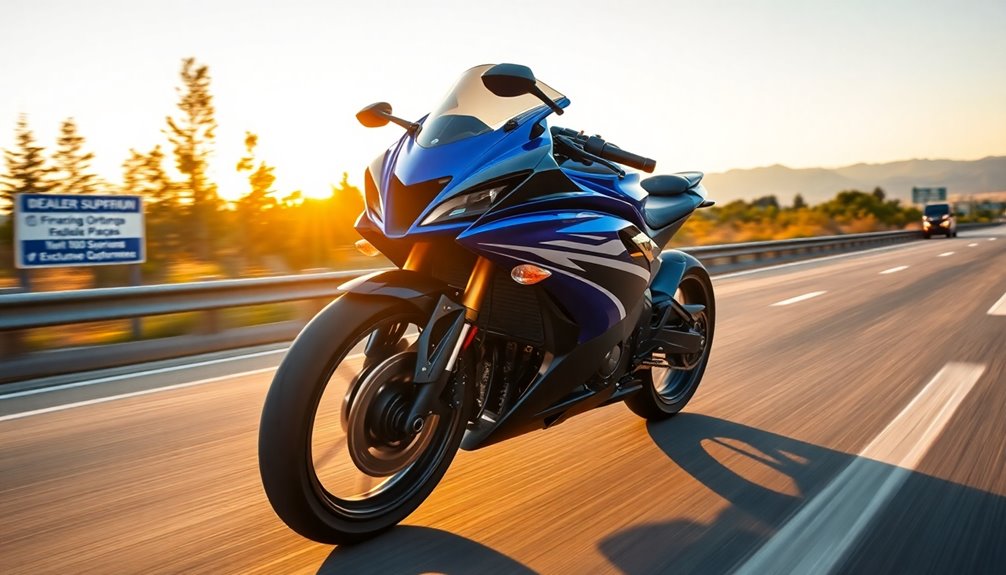
As you consider the cost of the 2025 Yamaha YZF-R6, it's important to note that the Race Base Model is priced at $9,461.44, reflecting a slight increase from the previous year.
Compared to its competitors, the R6 remains competitively priced, especially considering the upcoming YZF-R9, which starts at $12,499. The YZF-R9 is marketed as the spiritual successor to the YZF-R6, offering advanced technology and performance for sports bike enthusiasts.
If you're looking into financing options, Yamaha offers attractive plans. You can benefit from 0% APR financing for up to 60 months, amounting to just $16.67 per month per $1,000 financed.
There are also promotional APR rates ranging from 3.99% to 14.99% available for new models. Be mindful that these offers are valid from October 1, 2024, to December 31, 2024, and require approved credit through Yamaha Financial Services.
When purchasing, remember that the YZF-R6 Race Base Model is available for order through authorized dealers, with a reservation system in place from September 25 to November 29, 2024.
Make sure to check for any customer cash offers or promotions that might be running to get the best deal on your new ride.
Track Day Enthusiasts
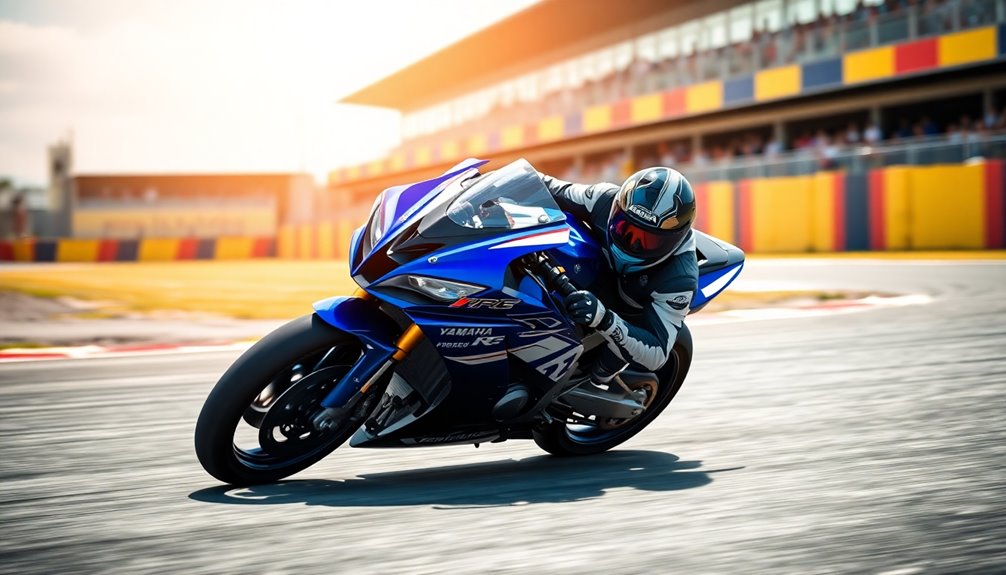
For track day enthusiasts, the Yamaha YZF-R6 delivers an exhilarating experience that few can match. With a potent 600 cc inline-4 engine producing 120 ps and 68 Nm of torque, you'll feel the adrenaline surge as you accelerate from 0-60 mph in just 3.0 seconds. The R6 doesn't just excel in acceleration; it also boasts a top speed of 172.34 mph, setting the bar for 600cc supersport motorcycles.
When you hit the track, the bike's Deltabox frame design provides exceptional stability, allowing you to carve corners with confidence. The 43 mm inverted front fork and upgraded rear shock enhance handling, ensuring you stay glued to the asphalt. Additionally, the R6's impressive power output is influenced by its high-revving engine capabilities, producing maximum power at 15,000 rpm.
With the YCC-I variable-length intake system, you'll experience optimized power delivery, making every lap thrilling. Equipped with ABS brakes, riding modes, and traction control, the R6 is designed for precision and safety, giving you peace of mind as you push your limits.
Whether you're racing against the clock or testing your skills, the Yamaha R6 stands out as a top-performing machine that's ready to dominate the track.
Frequent Tire Wear Issues
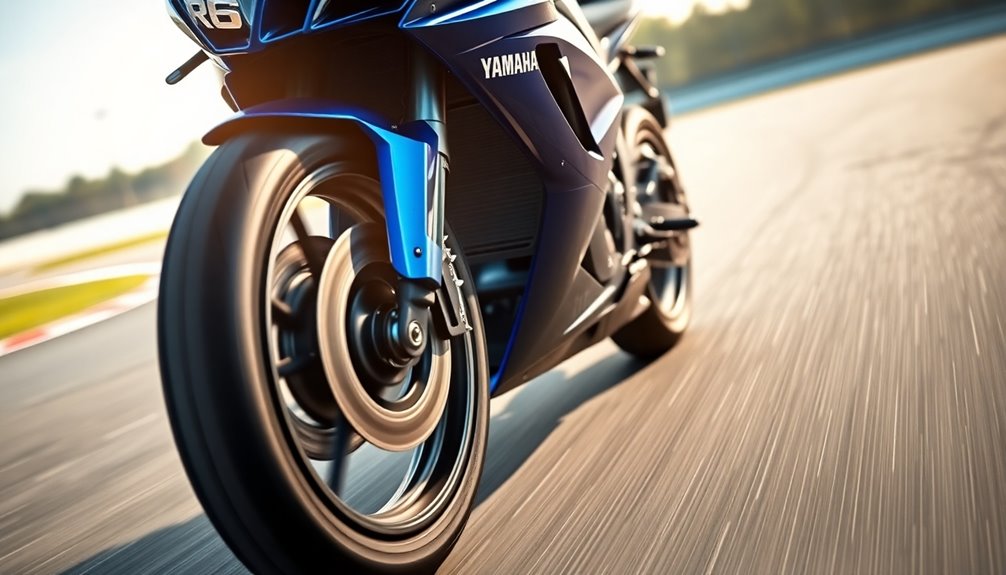
Tire wear is a common concern for riders of the Yamaha R6, especially those who frequently hit the track. High cornering speeds and aggressive riding styles can lead to uneven tire wear, significantly shortening your tire's lifespan. It's crucial to maintain the recommended tire specifications: a front tire size of 120/60 ZR17 and a rear tire size of 180/55 ZR17. Make sure to check your tire pressure regularly, ideally keeping it at 2.50 bar for the front and 2.90 bar for the rear, whether you're riding solo or with a passenger.
Improper tire pressure can accelerate wear, while rough road conditions and lack of maintenance will add to the problem. Look out for symptoms like uneven tread depth, cracks, bulges, and reduced grip. Regularly inspect your tires for any signs of dry rot, as this can indicate aging and lead to further deterioration of performance.
If you notice vibrations or unusual noises from your tires, it's time to inspect them closely. Regularly checking for wear and maintaining proper tire pressure can help you avoid costly replacements. Don't forget to schedule professional inspections, especially before long rides or track days, to ensure your tires are up to the task. Keeping your tires in check is vital for both performance and safety.
Robust Braking System Features

While keeping an eye on tire wear is important, the Yamaha R6 also boasts a robust braking system that enhances your riding experience. With dual 320mm front discs paired with four-piston, radially mounted calipers, this bike delivers exceptional stopping power. The floating discs provide superior heat dissipation, ensuring consistent performance during intense rides. Additionally, the Curb Weight of the bike at 189.2 kg contributes to its agile handling and braking efficiency.
At the rear, a single 220mm disc with a single-piston caliper maintains balance without compromising performance.
You'll appreciate the Electronic Braking Aids, including an Anti-lock Braking System (ABS) designed to prevent wheel lock-up, integrating seamlessly with other electronic systems for stable braking. If you prefer a more stripped-down setup, ABS delete modules can be installed easily, so you won't worry about error lights.
The advanced suspension system further complements the braking features. With 43mm inverted forks and a monoshock rear suspension, both adjustable for preload and damping, you'll feel a planted stability that enhances braking performance.
This combination of high-performance technology, derived from MotoGP experience, ensures you get outstanding feel and remarkable stopping power, making the Yamaha R6 not just a bike, but a complete performance package.
Exceptional Cornering Stability

Exceptional cornering stability is one of the standout features of the Yamaha R6, making it a favorite among sportbike enthusiasts. The compact aluminum Deltabox chassis, paired with a magnesium alloy sub-frame, offers a high strength-to-weight ratio that enhances handling. This narrower frame design improves aerodynamics, allowing you to slice through the air effortlessly.
When you ride, you'll notice how the centralized engine and components create a more balanced feel, enhancing your control during tight turns.
The Kayaba USD suspension with a 43mm inner tube ensures a planted feel, expertly managing stresses from uneven ground and tire trajectory changes. You'll appreciate how the suspension settings, tailored from the YZF-R1, provide exceptional damping force that keeps you stable at high speeds. Additionally, the R6's high-revving engine ensures smooth power delivery, allowing you to maintain momentum through corners effortlessly.
Plus, the advanced traction control system maintains rear wheel grip, giving you confidence when accelerating aggressively.
With an aerodynamic front cowl inspired by MotoGP and a short wheelbase offering optimal weight distribution, the R6 is designed for confident cornering. The integrated turn signals reduce drag, enhancing your ride experience even further.
With these features, the R6 delivers unmatched stability, making each corner a thrill ride.
Frequently Asked Questions
What Is the Yamaha R6's Top Speed in Ideal Conditions?
In ideal conditions, you can achieve a top speed of 161.3 mph on the Yamaha R6.
Your skill as a rider plays a crucial role in reaching this speed, as perfect launch techniques and proper shifting are essential.
Keep your RPMs above 9,000 to maximize performance, and manage your clutch carefully to avoid bogging down the engine.
With the right approach, you'll experience the thrill of this impressive speed.
How Does the R6 Compare to Older Models in Terms of Speed?
When you compare the R6 to older models, you'll notice minimal differences in top speed, with both hovering around 157-162 mph.
Acceleration times are similarly competitive; you'll find newer models hitting 0-60 mph in about 3.2 seconds.
While older models boast slightly higher horsepower, the newer ones offer improved torque delivery and fuel efficiency.
What Modifications Improve the R6's Top Speed?
To improve your bike's top speed, consider several modifications. Increasing engine displacement can boost power, while high-performance camshafts and porting enhance airflow.
Tuning the ECU optimizes performance and throttle response. Adjusting the final drive ratio by changing sprocket sizes allows you to fine-tune for either acceleration or speed.
Lastly, aerodynamic enhancements like lightweight materials and wind tunnel-tested bodywork can significantly reduce drag, improving overall performance and top speed.
Are There Speed Limitations for Beginner Riders on the R6?
Yes, there are speed limitations for beginner riders on powerful bikes like the Yamaha R6.
Many regions impose laws restricting new riders from operating motorcycles above a certain engine size, often around 250cc. These regulations help ensure safety as beginners learn the skills necessary for handling high-performance machines.
It's crucial to choose a bike you can manage comfortably to avoid accidents and develop your riding abilities gradually.
Always prioritize safety and proper training.
What Factors Affect the R6's Top Speed Performance?
Several factors influence the R6's top speed performance.
Your weight plays a crucial role; the lighter you are, the better the acceleration and speed.
Aerodynamics matter too—streamlined bodywork reduces drag.
Weather conditions, like headwinds, can hinder your speed as well.
Plus, effective gear shifting and clutch management are essential; you should maintain optimal RPMs during acceleration.
Finally, the overall load, including any passenger or luggage, can significantly impact the bike's performance.
